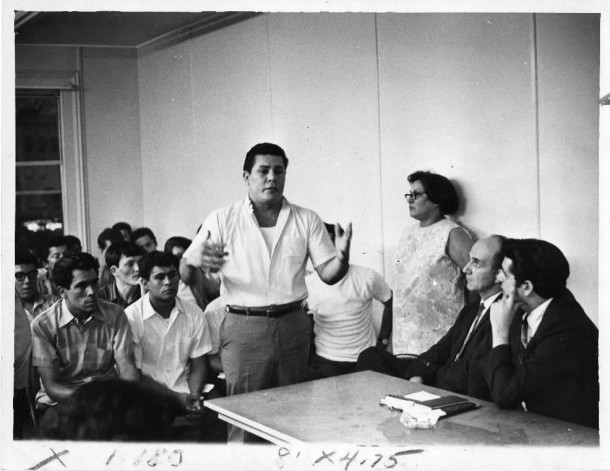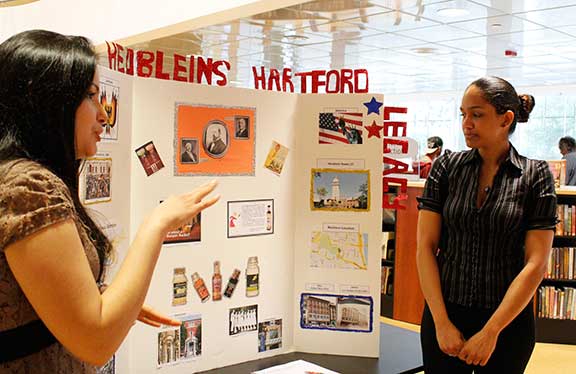In spring 2013 students from Capital Community College’s Liberal Arts Capstone Course conducted research at Hartford Public Library’s Hartford History Center. Led by Dr. Jeffrey Partridge, students explored important figures from Hartford’s history and their immigrant, migrant, or ethnic communities that culminated in presentations of their semester-long research projects.
Projects included former mayor Ann Uccello, Educator Annie Fisher, Gwendolyn Reed and the “Aunt Jemima” brand, the Heublein Company, Community leader Maria Sanchez, Founder Francis Goodwin, Architect George Keller, and the Fuller Brush Company, among others.
We are honored here at ConnecticutHistory.org to present to you excerpts of some of the final projects, as well as student observations on immigration, their families, school, and growing up in and around Hartford…In their own words.
I thought to myself I already knew everything there was to be known on immigration. In this class I got to find out that that was not necessarily the case. We got to see that the city where I grew up in Hartford, Connecticut was in fact a city of immigrants as well as made by immigrants. ~Anthony Parra
I thought I was the only one struggling as an immigrant, who strives for better future. The first day of the seminar that we had in class, I actually cried because I was so lost, but with the topics of Immigration that we have discussed during this semester, I started to understand that immigrants have always struggled for a certain amount of time seeking their dreams on the “Promised Land.” ~Besarta Qorri
Immigration seems to be a constant concern for America, even though the country is a nation of immigrants. America is known as a diverse country because it welcomes people from many different countries, races, and religion. ~Chandrika Reddy
I came into the Capstone course simply as the daughter of an immigrant, and I am leaving as an extremely proud immigrant’s daughter. [The class] gave me a greater appreciation for my father and the dreams he held for himself and his future family.~ Amanda Duenes
People always say America is a melting pot, but after learning what I have I believe we are a salad and everything that goes into it makes us better and is still seen and known for what it is. ~Ciyavah Daniels
I believe the more diverse we are, the more we learn from each other, and the more we understand each other. If we could accomplish that, we would not be fighting and destroying each other all the time. Instead, we would be working together to build each other up. ~Martin A. Sharpe, Jr.

Maria Sánchez (leaning against the wall) in a meeting with city officials, Hartford, 1969 – Hartford History Center, Hartford Public Library and Connecticut History Online
Maria C. Sanchez by Tanisha Pino
Maria opened up her News Stand, “Marias News Stand,” in the late 1950s. She used this as a place to hold meetings in order for people to voice their concerns of mistreatment. She wanted to be the voice of the people; she also wanted her store to be educational. She wanted Puerto Ricans to come, see what is going on outside their world, and realize they have rights, that things cannot stay the same. There was hope for the future if everyone was willing to fight for it. In 1965, George Ritter was campaigning for a seat on the city council. He knew what would make his votes stand out was the votes of the Puerto Ricans. In order to acquire these votes he hired Maria Sanchez and appointed her treasurer of the group. The social unrest continued to grow in the hearts of the Puerto Ricans and led to the “Comanchero Riot” on August 10th, 1969. A fight had erupted between the French Canadian communities and the Spanish communities. It was clear that Maria was able to get communities rattled up and lead them to make changes.
Maria Sánchez: “la madrina” of Hartford’s Latinos by Juan Jeffrey
Once Maria arrived on the mainland, she immediately became active in the growing Puerto Rican community alongside other key players such as Olga Mele, who registered Sanchez to vote in 1955 the year following her immigration. Along with Olga and other members of the growing Puerto Rican community in Hartford Maria began working to address the disparity of living conditions, employment opportunities, and education attainment for Puerto Ricans. In 1959 along with other activists, Sanchez organized a petition to bring Spanish-speaking priests to address the needs of the growing Puerto Rican community. Using tactics similar to the Irish in the early 20th century, in 1964 Sanchez along with the Spanish Action Committee organized the first Puerto Rican Day Parade. As Sanchez put it, the demonstration served two purposes “first, the parade is entertainment and enjoyment of Puerto Rican life, second is serves to show politicians throughout the state the large voting potential of the Puerto Rican community.”
George Keller: The Man in the Arch by Amanda Duenes
Following the outbreak of the Civil War, George Keller went forth to join the Union Army, but changed his mind just as he was on the point of signing up. From there, George “sought to obtain a lieutenancy in a company,” yet failed in doing this. It was at this point, at the age of sixteen, that he moved to Washington, DC, to work for Charles F. Anderson, an architect best known for designing the Senate and House wings on the National Capitol. Approximately one year later, he was hired by the Brooklyn Navy Yard to design buildings necessary for the Civil War effort. From there, at the age of twenty-two, J.G. Batterson persuaded him to come to Hartford to design cemetery memorials for Hartford’s rich and famous.
Gwendolyn Clarke Reed: Rich in Spirit by Manuel Bourgeois
Gwen was best known for her 17-year period posing as Aunt Jemima, the fictional cook of the Quaker Oats pancake and syrup brand, from 1946 to 1964. This position did give Gwen steady employment but even this did not come without controversy. Some civil rights leaders resented the Aunt Jemima image. They considered this was perpetuation of a stereotype and because of this and social changes, Quaker Oats limited Aunt Jemima to its pancake packages. Gwen however could never be the stereotype. She “has dignity and beauty of character that compel respect, as pathos on stage forces tears.” Gwen captivated audiences traveling across the country through places such as grocery stores, school assemblies, carnivals, and state fairs with the Quaker Oats Company. In 1955, she was awarded for Outstanding Accomplishments in the Sales Promotion and Merchandising of Aunt Jemima Products. In 1963, she was awarded for 16 years of Meritorious Service. Gwen was admitted into the Aunt Jemima Hall of Fame.
Gwendolyn Reed (1912-1974) by Melissa Love
Gwendolyn’s resume is very impressive; however, it was not easy for an African American actress to find work in those days especially after the depression. According to Christopher Baker in his article “From Fields to Footlights,” there was some discrimination against the African American actors because the Works Progress Administration (WPA), who was supposed to fund all actors despite race, did not. Unfortunately, The Project Theatre’s Negro Units received less support from the WPA than the White actors did. The only roles available for Gwendolyn or any other African American were playing as servants. Some of the plays listed on Gwendolyn’s Resume were 1936-1938 she acted for the Connecticut Federal Theatre in “Pogy”, “Mississippi Rainbow”, “Field God”, “1/3 of a Nation”, “Haiti”, “Jericho” and others. From 1942-1948 she was in “The Willow and I”, “Little Foxes”, “Another Part for the Forest” and “Stage Door.” (Gwen Reed’s Resume) From 1945-1946 Gwen was in “Dear Ruth”, “Male Animal”, and “Three’s a Family”. In 1951, Gwendolyn was a director for the Hartford Community Players and from then until 1967 she was in “Rain,” “A Raisin in the Sun,” and “Purlie Victorious” where she won the Herald Award for best supporting actress. In between some of these plays, she was Aunt Jemima and when she could not get a role she worked in the tobacco field.
Andrew Heublein and Sons: True Legends of Hartford by Jessica Rufino Tineo
Andrew Heublein came to this country in 1856 accompanied by his wife and five children. The first few years the Heublein family lived in New Haven, CT where he started working in the Goodyear Rubber Company at Beacon Falls. There he applied the knowledge he gained in Prussia Germany on how to perform this type of job. However, in 1959 with a small capital, and a pretty good idea in mind, he decided to move to Hartford to start his own business.
During the 1800s to the middle 1900s Hartford had a very attractive economic importance. During those eras, Hartford was a river town when trade became one of the economically most important activities of the Industrial Revolution. Hartford’s manufacturing plants and large insurance companies not only turned Hartford into one of the richest and most important cities of the US, they made Hartford a focal point for hundreds of immigrants that were looking for employment at that time.
This economic importance of Hartford was what attracted Andrew Heublein to establish Heublein’s Hotel restaurant and beer salon on Mulberry Street, Hartford in 1862. Since the beginning, the business became one of the favorite places for businessmen and politicians to meet, and years later in one of the biggest and most important liquor business of the entire State of Connecticut and all the United States. During thirteen years, Andrew Heublein was the head of the business, but because he wanted his sons to get involved in the business in 1875 he decided to relinquish the business to his sons Gilbert and Louis.
The Heubleins: Honorable Hartford Germans by Rosa Giordano
One of the worst moments that the Heublein companies faced was in 1919 when the national prohibition act was passed, and as consequence one of their biggest liquor plants, an important part of their business was forced to close down. What helps them overcome this situation was that not too long before the prohibition they had acquired A-1 sauce, (sauce that we still find in the supermarket) which helped their sales. The Heubleins kept growing in business and once the 18th amendment was passed they reentered the market by opening another plant, this time on 285 Broad Street. This was a more modern plant than the one before on Trumbull Street. With the new plant on Broad Street, more employment was created in Hartford; however, they employed highly trained experts and craftsmen, probably other German immigrants. From 285 Broad St., the Heubleins moved to 330 Park Ave, they were all over Hartford, and always located in busy focus points.

On the day Dr. Martin Luther King Jr. was assassinated, Hartford Mayor Antonia “Ann” Uccello went to where citizens were gathering in the streets of North Hartford and spent the night with them, talking and consoling. One of the first women in America to be elected mayor of a major city, “Mayor Ann” famously asked her city’s grieving residents “What would Dr. King want you to do?.” Photographer Unknown – The Hartford Times Collection, Hartford History Center, Hartford Public Library
Antonina Uccello: The Pioneer of the Italian Immigrants by Chandrika Reddy
Ann Uccello and many other immigrants have had a positive impact on the United States. As a second-generation immigrant, Antonina Uccello became the first woman mayor of Hartford. Her “American Dream” began when her parents immigrated from Canicattini Bagni, Italy in 1920 to the United States, the land of opportunity. Immigration to the United States was very prominent in the early 20th century especially among Italians escaping the social and economic hardships in rural Europe. Italy’s economy was suffering and the laborers were affected by the “competition from other agricultural countries.” Since the United States economy was thriving, it would only make sense for the laborers to journey to the industrialized cities.
Hartford as an industrialized city attracted Italian immigrants, although “their fundamental role was to provide unskilled labor.” Italians were generally employed in construction and railroad track work, they were the poorest paid in the city. Italian immigrants did not acquire the skills to operate certain machines in Italy, which hindered them from obtaining high paying jobs in the United States. However, “masonry and shoe repair were two notable expectations to the generalization that Italians performed only unskilled labor.” Ann Uccello’s father processed the skills needed to establish a shoe repair business in Hartford, CT, still he expressed that “raising the girls during the Depression wasn’t easy.”
We would like to thank Dr. Partridge’s students for their hard work and dedication to history in Connecticut, and would like to thank them for letting us give to you, the reader, a glimpse into both the past and the classroom. We wish them well in their endeavors and look forward to working with Dr. Partridge and his students at Capital Community College again.
~The ConnecticutHistory.org team










